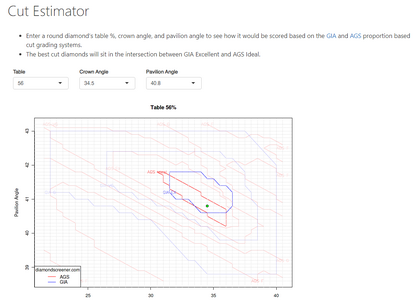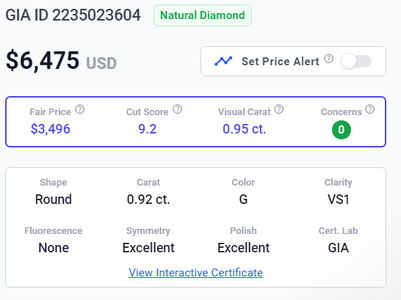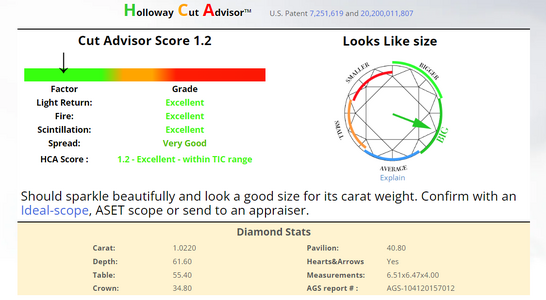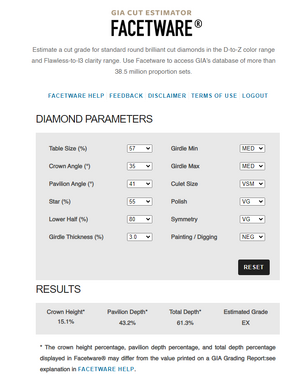- Joined
- Jul 27, 2009
- Messages
- 4,097
When shopping for diamonds online, cut quality is one of the most important factors to consider. While several helpful online tools exist that attempt to predict cut quality, they all fall short of truly determining a diamond's light performance. Here’s a look at some of the most popular tools - which ones are the best and why:
The diamond screener Cut Estimator tool is the simplest and most limited; it is applicable only to round diamonds and based upon three very simple user-supplied inputs – table %, pavilion angle, crown angle. Not only does this represent the contribution of only 17 of the diamond’s 57 facets, but taken from a laboratory report these measurements are averaged and/or rounded to varying degrees. The Cut Estimator makes no effort to render an independent score, it simply presents a graph of where the stone lands on three parameters viewed on overlayed tables of GIA Excellent and AGS Ideal. Like other parametric estimators the tool must assume perfect faceting precision (which is anything but a fair assumption!), as there is no input for this important factor, nor can it even be gleaned from a GIA report.
Customers are somewhat misleadingly advised that the best diamonds are those that “sit in the intersection between GIA Excellent and AGS Ideal”. It is important to note that AGS departed from a parameter based system in 2005 and launched a revolutionary light performance based system that performs sophisticated ray tracing on a 3D model of the actual diamond, taking the contribution of all facets into account.
Diamond Screener makes no effort to explain the limitations of their tool or the proper use for it.

Stone Algo
This cut estimator uses the laboratory report number to retrieve the parameters from the report to return a cut quality score. This saves inputting time and eliminates user mistakes, but is limited to GIA, AGS, and IGI reports . And it necessarily contains the same averaging and rounding variances of the report itself.
It renders a score on a 1-10 scale with 10 being “perfect”, but not attainable. A lengthy explainer of the tool is available on the website, but despite some impressive trade speak it looks like the only difference from a simple estimator like Diamond Screener is that they are factoring in girdle thickness as a 4th parameter. They don’t explain how the score is actually calculated instead saying “After studying a long list of technical and non-technical resources we were able to work out our own formula” . That said, their disclaimers and limitations are clearly stated, and this statement of theirs pretty well describes all of the online tools:
“Like all mathematical models that seek to replicate physical objects based on limited data, the StoneAlgo Cut Quality Score is not an exact representation of a diamond's physical beauty. The data we use is two dimensional, and a diamond is a 3D object. We are forced to assume that the angles and widths are consistent in 360 degrees around the diamond, but this is often not the case.”

One aspect of the Stone Algo site that should be completely disregarded is the “fair price” feature. Not only is the diamond quality predicated on their cut score that cannot factor in facet precision or other important quality factors, it does not take into account any added value for things like advanced light performance imaging, in-house vetting, or other valuable benefits.
Holloway Cut Advisor (HCA)
Pricescopers are well acquainted with the HCA, developed by local legend Garry Holloway Like the others HCA relies on inputs from a laboratory report. But in addition to a score, the tool gives predictions of light return, fire, scintillation, and spread. The “Looks Like” feature is a graphical expression of “spread” which indicates if a diamond looks small or big for its carat weight. Like others, this estimator only works for round diamonds.
Like the others HCA relies on inputs from a laboratory report. But in addition to a score, the tool gives predictions of light return, fire, scintillation, and spread. The “Looks Like” feature is a graphical expression of “spread” which indicates if a diamond looks small or big for its carat weight. Like others, this estimator only works for round diamonds.

What sets HCA apart from other cut estimators, in addition to its extra features, is the transparency of the methodology. The underpinnings of the system are explained and limitations noted. The tool has been issued patents so technical details are a matter of public record. The developer makes it clear that the tool is designed to help reject problematic stones but that it is NOT a selection tool. When promising candidates are found using the HCA, advance images such as ASET , IdealScope and Hearts and arrows views are recommended to confirm actual performance and make a selection.
The tool renders a grade from 10 to 0 , with diamonds graded at 2 or below considered good candidates. Interestingly, this is not an absolute scale- a diamond at 1 is not necessarily better than a diamond at 2. And it is recommended that diamonds scoring 1 or below are better for pendants and earrings as the spread factor is heavily weighted in the scoring. Very spready diamonds are usually shallower and more prone to obscuration (darkness) from head shadow. Since pendants and earrings are usually observed at greater viewing distances than rings, this is less of an issue.
The HCA also has the advantage of being able to plug in the certificate number to prefill the fields. And like the diamond screener tool it creates a graph that shows where the diamond’s basic parameters fall on both the GIA and AGS tables. In addition, it is possible to input a factor for high facet precision if the diamond is known to be hearts and arrows that will be factored in the score.
Of the parameter based tools available online HCA stands out for having the most features and for the transparency of the underlying theory and workings of the system. It is also the tool that most honestly states its intended purpose and its limitations.
GIA Facetware
This online tool from GIA is the same type of parameter based system as the other online tools but is tied to the GIA grading system. It does not render an independent “score” but rather predicts how a given round diamond will grade in their cut system. There are options for additional parameters, so in this regard it is likely more accurate than other online tools, although GIA includes the clear caveat that actual grading results may vary. The GIA cut grading system, while still parameter based, does receive inputs from an accurate scan of the diamond when graded at the lab. It will be able to see things like precision faults and non-standard brillianteering which the 2D Facetware tool cannot know.

Facetware is a solid tool, but it has some of the same limitations the other 2D parametric tool have. And considering that even if the result is Excellent, this category is so broad that other information about the diamond is needed (such as advanced imaging) in order to understand actual performance. Thus, like others it serves only as a rejection tool.
But given that most of the diamonds being shopped already have GIA reports, using it is largely redundant and is therefore of little use to most online shoppers.
Limitations Common to Online Cut Estimators
On several websites you can find listings of fancy shape diamonds with cut grades. A consumer should take these claims with MORE than a grain of salt. There’s a reason GIA still does not put an overall cut grade on non-round diamonds. There is a much more complex interrelationship between parameters and characteristics such as facet design, length to width, proportions and specific facet angles and azumiths that determine the appearance and light performance of a fancy shape.
The landscape with respect to cut grading of fancy shapes will likely change in the near future now that GIA owns the AGS light performance grading technology which is capable of grading fancy shapes. In fact, a little know fact is that GIA is already offering AGS Ideal addendum reports on fancy cut diamonds that qualify.
Conclusion
There are a variety of helpful online tools that can be used to filter out diamonds with problematic cut parameters, and which allow a shopper to focus on just those that “make the cut”, and the HCA is top of the class. But selecting a diamond from a pool of potential candidates requires more information than any of these tools provide. Advanced light performance imaging such as ASET, IdealScope and Hearts and Arrows scope provide that additional information, along with high quality video.
What tools do you use when shopping for diamonds? What are your thoughts on cut quality estimators?
- Diamond Screener - Cut Estimator
- Stone Algo - Cut Score
- Holloway Cut Advisor (HCA)
- GIA Facetware
The diamond screener Cut Estimator tool is the simplest and most limited; it is applicable only to round diamonds and based upon three very simple user-supplied inputs – table %, pavilion angle, crown angle. Not only does this represent the contribution of only 17 of the diamond’s 57 facets, but taken from a laboratory report these measurements are averaged and/or rounded to varying degrees. The Cut Estimator makes no effort to render an independent score, it simply presents a graph of where the stone lands on three parameters viewed on overlayed tables of GIA Excellent and AGS Ideal. Like other parametric estimators the tool must assume perfect faceting precision (which is anything but a fair assumption!), as there is no input for this important factor, nor can it even be gleaned from a GIA report.
Customers are somewhat misleadingly advised that the best diamonds are those that “sit in the intersection between GIA Excellent and AGS Ideal”. It is important to note that AGS departed from a parameter based system in 2005 and launched a revolutionary light performance based system that performs sophisticated ray tracing on a 3D model of the actual diamond, taking the contribution of all facets into account.
Diamond Screener makes no effort to explain the limitations of their tool or the proper use for it.

Stone Algo
This cut estimator uses the laboratory report number to retrieve the parameters from the report to return a cut quality score. This saves inputting time and eliminates user mistakes, but is limited to GIA, AGS, and IGI reports . And it necessarily contains the same averaging and rounding variances of the report itself.
It renders a score on a 1-10 scale with 10 being “perfect”, but not attainable. A lengthy explainer of the tool is available on the website, but despite some impressive trade speak it looks like the only difference from a simple estimator like Diamond Screener is that they are factoring in girdle thickness as a 4th parameter. They don’t explain how the score is actually calculated instead saying “After studying a long list of technical and non-technical resources we were able to work out our own formula” . That said, their disclaimers and limitations are clearly stated, and this statement of theirs pretty well describes all of the online tools:
“Like all mathematical models that seek to replicate physical objects based on limited data, the StoneAlgo Cut Quality Score is not an exact representation of a diamond's physical beauty. The data we use is two dimensional, and a diamond is a 3D object. We are forced to assume that the angles and widths are consistent in 360 degrees around the diamond, but this is often not the case.”

One aspect of the Stone Algo site that should be completely disregarded is the “fair price” feature. Not only is the diamond quality predicated on their cut score that cannot factor in facet precision or other important quality factors, it does not take into account any added value for things like advanced light performance imaging, in-house vetting, or other valuable benefits.
Holloway Cut Advisor (HCA)
Pricescopers are well acquainted with the HCA, developed by local legend Garry Holloway

What sets HCA apart from other cut estimators, in addition to its extra features, is the transparency of the methodology. The underpinnings of the system are explained and limitations noted. The tool has been issued patents so technical details are a matter of public record. The developer makes it clear that the tool is designed to help reject problematic stones but that it is NOT a selection tool. When promising candidates are found using the HCA, advance images such as ASET , IdealScope and Hearts and arrows views are recommended to confirm actual performance and make a selection.
The tool renders a grade from 10 to 0 , with diamonds graded at 2 or below considered good candidates. Interestingly, this is not an absolute scale- a diamond at 1 is not necessarily better than a diamond at 2. And it is recommended that diamonds scoring 1 or below are better for pendants and earrings as the spread factor is heavily weighted in the scoring. Very spready diamonds are usually shallower and more prone to obscuration (darkness) from head shadow. Since pendants and earrings are usually observed at greater viewing distances than rings, this is less of an issue.
The HCA also has the advantage of being able to plug in the certificate number to prefill the fields. And like the diamond screener tool it creates a graph that shows where the diamond’s basic parameters fall on both the GIA and AGS tables. In addition, it is possible to input a factor for high facet precision if the diamond is known to be hearts and arrows that will be factored in the score.
Of the parameter based tools available online HCA stands out for having the most features and for the transparency of the underlying theory and workings of the system. It is also the tool that most honestly states its intended purpose and its limitations.
GIA Facetware
This online tool from GIA is the same type of parameter based system as the other online tools but is tied to the GIA grading system. It does not render an independent “score” but rather predicts how a given round diamond will grade in their cut system. There are options for additional parameters, so in this regard it is likely more accurate than other online tools, although GIA includes the clear caveat that actual grading results may vary. The GIA cut grading system, while still parameter based, does receive inputs from an accurate scan of the diamond when graded at the lab. It will be able to see things like precision faults and non-standard brillianteering which the 2D Facetware tool cannot know.

Facetware is a solid tool, but it has some of the same limitations the other 2D parametric tool have. And considering that even if the result is Excellent, this category is so broad that other information about the diamond is needed (such as advanced imaging) in order to understand actual performance. Thus, like others it serves only as a rejection tool.
But given that most of the diamonds being shopped already have GIA reports, using it is largely redundant and is therefore of little use to most online shoppers.
Limitations Common to Online Cut Estimators
- Only applicable to rounds
- Use averaged and rounded measurements
- Do not factor the contribution of all facets
- Do not factor facet precision (optical symmetry)
- 2D analysis based on pre-defined tables
On several websites you can find listings of fancy shape diamonds with cut grades. A consumer should take these claims with MORE than a grain of salt. There’s a reason GIA still does not put an overall cut grade on non-round diamonds. There is a much more complex interrelationship between parameters and characteristics such as facet design, length to width, proportions and specific facet angles and azumiths that determine the appearance and light performance of a fancy shape.
The landscape with respect to cut grading of fancy shapes will likely change in the near future now that GIA owns the AGS light performance grading technology which is capable of grading fancy shapes. In fact, a little know fact is that GIA is already offering AGS Ideal addendum reports on fancy cut diamonds that qualify.
Conclusion
There are a variety of helpful online tools that can be used to filter out diamonds with problematic cut parameters, and which allow a shopper to focus on just those that “make the cut”, and the HCA is top of the class. But selecting a diamond from a pool of potential candidates requires more information than any of these tools provide. Advanced light performance imaging such as ASET, IdealScope and Hearts and Arrows scope provide that additional information, along with high quality video.
What tools do you use when shopping for diamonds? What are your thoughts on cut quality estimators?







300x240.png)